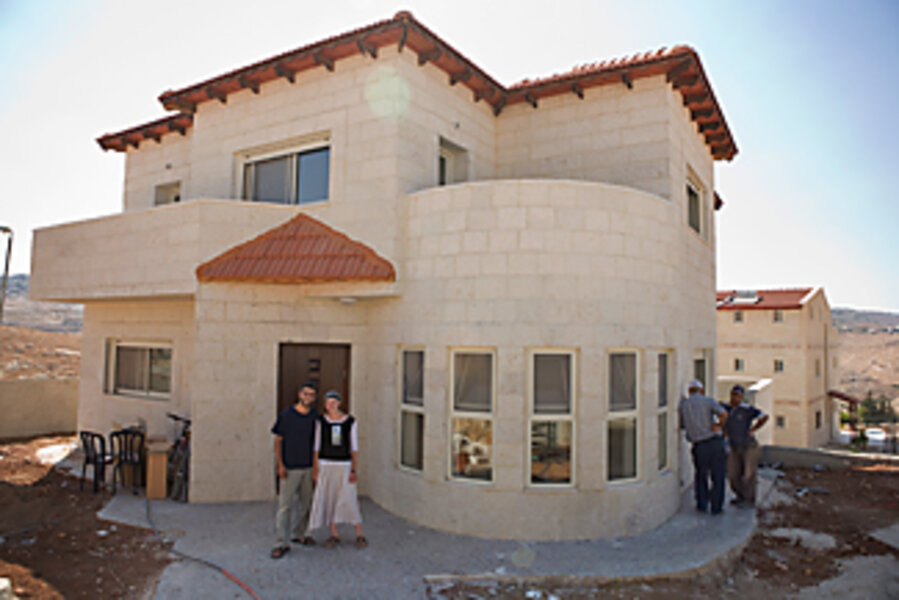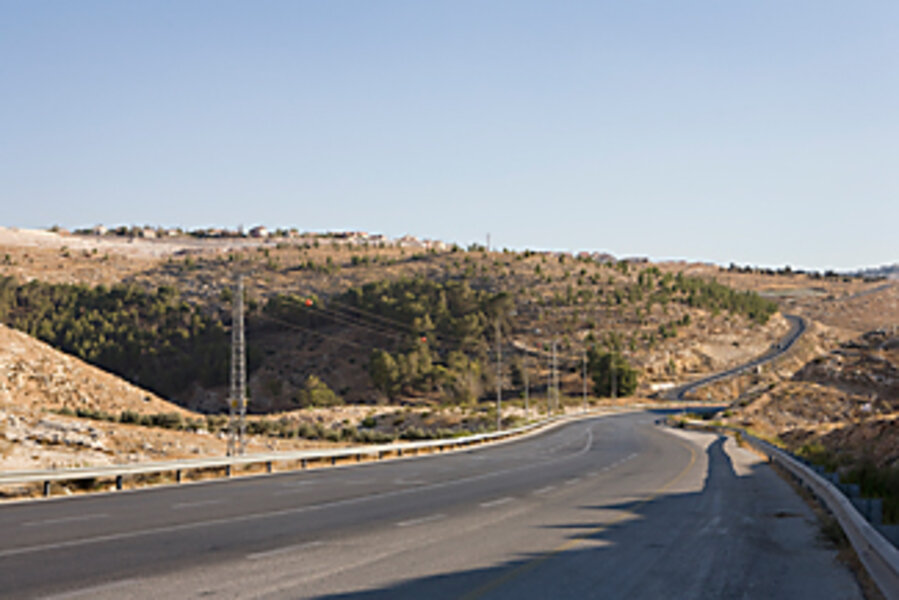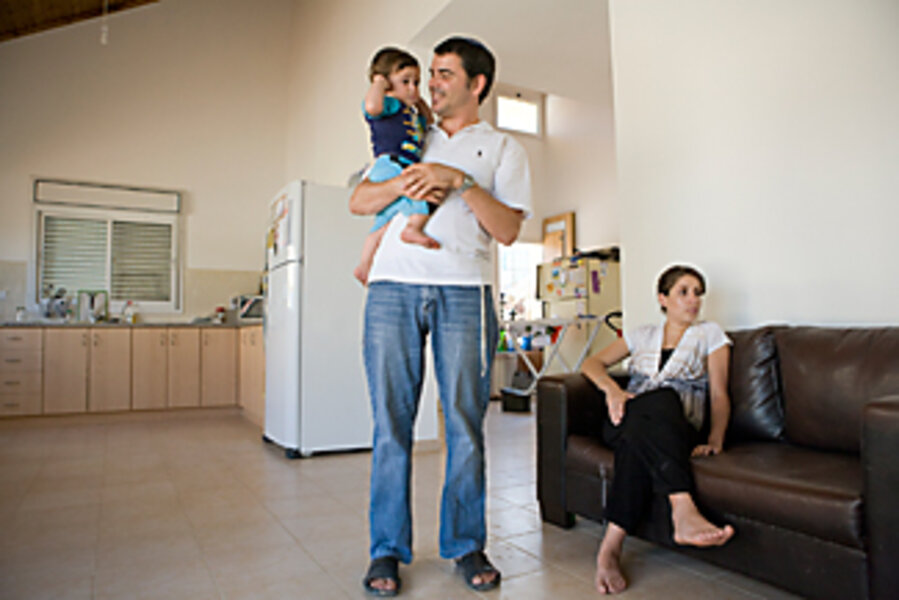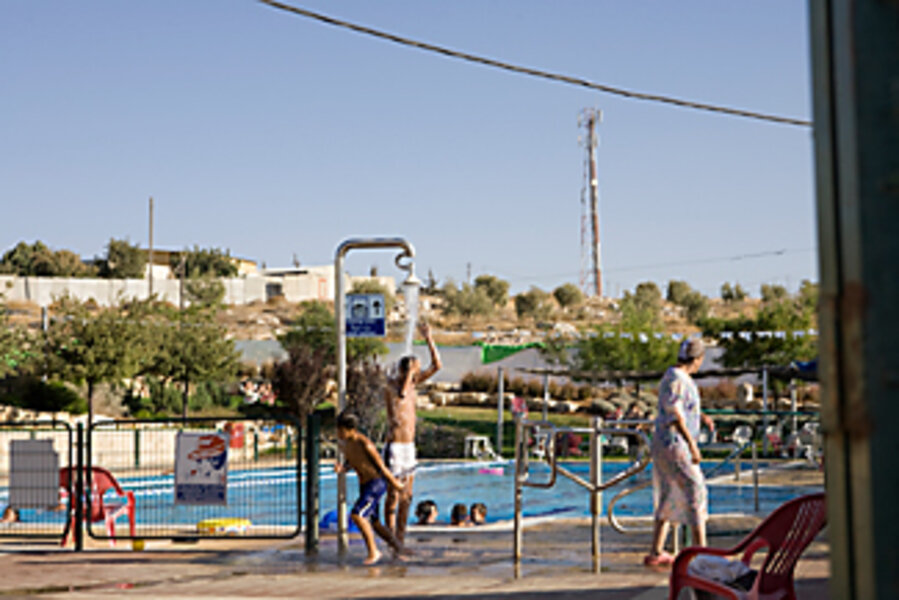West Bank settlements become havens of Israeli surburbanites
Loading...
| Kiryat Netafim and Tekoa, West Bank
Meet the Ovadiahs, the Allons, and the Cohens. They're new arrivals in Israeli neighborhoods where freshly laid red-tile roofs and toddler toys dotting green lawns are a picture of the Israeli equivalent of the American dream, minus the white picket fence.
But the sounds wafting through the air – the constant clank of construction, and the Muslim call to prayer from nearby Palestinian villages – speak to the larger context in which their new homes are located. All three families have recently bought homes in West Bank settlements, where the rate of population growth – three times that of Israel alone – is the subject of great global dispute.
For the past decade, an annual average of more than 10,000 newcomers have settled in this disputed territory – a portion of that growth was babies born to growing families. In the years 2006 through 2008, a yearly average of 14,100 new residents of West Bank settlements were registered by Israel's Central Bureau of Statistics – the biggest growth spurt, in sheer numbers, in recent Israeli history.
That growth has vastly different meaning locally, nationally, and globally.
To Palestinians, it means an expansion of the occupation.
In the Israeli narrative – in which the world's censure of settlement growth seems to have been reduced to background noise for families like the Ovadiahs, Allons, and Cohens – the growth is beginning to look like little more than suburbanization. They came in search of quiet bedroom communities that boast ample space, pretty landscapes – and some of the best home values in Israel.
Through the lens of the international community, West Bank growth impedes renewed efforts to bring about a two-state solution to the Israeli-Palestinian conflict.
Bridging that disconnect is a major challenge for President Obama, who is expected this week to try to restart Middle East peace talks at the UN General Assembly, where he's scheduled to meet with Israeli Premier Benjamin Netanyahu and Palestinian Authority President Mahmoud Abbas.
This is the latest chapter in the on again, off again drama that has played out between Jerusalem and Washington for decades: Every US president since Lyndon Johnson has urged Israel not to build or expand settlements in the territories it occupied in the 1967 Arab-Israeli conflict. But with more than 300,000 Israeli settlers living in some 120 settlements – and Mr. Netanyahu exempting nearly 3,000 housing units from a six-month freeze – the settlement issue has only become more formidable. (Read a full briefing page on Israeli settlements here.)
BUT WHO ARE THE PEOPLE WHO WOULD CHOOSE to settle in the midst of such unsettled conflict?
It is not necessarily the well-armed ideologues who have characterized the settlement movement over the years. The bulk of settlers today, according to various surveys, come mostly for economic or "lifestyle" reasons.
About 30 percent of those are ultra-Orthodox Jews for whom the primary goal is living in an affordable religious com-munity, irrespective of whether it lies beyond the Green Line, Israel's pre-1967 borders. New immigrants, such as Americans and those from the former Soviet Union, make up a smaller portion.
Generally most don't like to be called settlers because, as one settlement council head says, settlers have been made out to be the world's "pariahs." But they might agree to be called the new settlers, if the word were to be used in the most positive sense, as in the early American pioneers.
With the West Bank in Israel's hands for 42 years, many middle-of-the-road Israelis see little reason not to move there – particularly to long-established, larger settlements, or those close to the Green Line.
They're educated, often upper-middle-class, and not exclusively from right-wing backgrounds. They're more likely to be armed with an iPod than an Uzi. And unlike the settlers who tend to grab headlines, they're not interested in using force or violence to stop another evacuation of settlements, largely expected to be a feature of any Israeli-Palestinian peace treaty.
But why take the risk of investing in a home on disputed territory? Among other reasons, settlers are bearish on the prospects of the peace process leading anywhere soon – if ever.
"THIS AREA IS NOT LIKELY TO EVER BE EVACUATED," says Moti Ovadiah, who moved to Kiryat Netafim a year ago, shortly after his wife, Vered, gave birth to their son, Ishai.
Kiryat Netafim, tucked into a comely, mountainous area – from which the Tel Aviv skyline is visible – is next to the settlement of Barkan and its large industrial park.
It's a sleepy area with little tension between the Jewish settlement and neighboring Palestinians villages, whose men work in Barkan. The community of 100-plus families identifies itself as a national-religious community – a stream of Israeli society that includes serving in the army and participating in the larger political and social fabric – making them distinct from most ultra-Orthodox.
And the price is right: The Ovadiahs paid $292,000 for a 1,300-square-foot, three-bedroom home. A comparable property would cost at least triple in any of the outlying Tel Aviv neighborhoods where Moti and Vered both grew up.
"It's a settlement lite," Moti says somewhat jokingly. "It's not like moving to East Jerusalem, to the heart of an Arab neighborhood, or into Hebron. We heard a lot of positive things about the area, came and looked, and just really loved it."
Vered is less in love. She's not quite as enthusiastic about the location of her new home, mostly because – 20 miles from Tel Aviv and one checkpoint from the Green Line – it feels too far from the center of the country. Her own mother, who still lives in a Tel Aviv suburb and is concerned about the safety of the area, avoids visiting. Likewise, some friends won't visit.
"But everyone loves the whole bit about the big house and the yard, and the magical view," Vered says, looking at her watch and then down the slope toward the nursery where she's due to pick up Ishai in a few minutes. She's pregnant with their second child. "I just want to live my life," she shrugs. "Ideology doesn't interest me."
But it does Moti. After studying journalism, he's been working as an aide to a Knesset member from the right-wing Yisrael Beytenu Party. The party's leader, Foreign Minister Avigdor Lieberman, also happens to live in a settlement. (Moti didn't vote for them, but cast his ballot for another right-wing party.)
"I don't go to demonstrations; I don't believe in them," says Moti, who identifies himself as a right-wing moderate.
"And it's hard for me to believe that they'll evacuate any of us, or that a Palestinian state is ever going to be formed," he says. "I don't think the Palestinians have the ability to run a state now, as divided as they are. And if an Israeli leader came home from negotiations with such a plan, I don't think there will be enough of a majority for it to pass in the Knesset. There's no political solution: We'll say it's all our land, they'll say it's all theirs, and we'll never get anywhere."
Outside, his street looks like a planned community anywhere: the look-alike homes with the perfect coat of paint, and the bare yard awaiting landscaping. Then the street gives way to unfinished houses in progress that Peace Now – a left-wing Israeli group that keeps a vigilant eye on settlement growth – says have been built illegally. Moti, though, is not worried; he thinks the courts will reject Peace Now's petition to have 15 of these houses destroyed.
"I had three priorities in choosing where to live," he explains. "The first was finding a good place to bring up kids. The second was financial. Third comes ideology," he says. "It's in that order. To think of only one of these is not the right approach to life. It's a mixed salad. But I'm also concerned that Vered be happy. I think she will be."
Vered, a cosmetician and manicurist, raises her shaped eyebrows and doesn't answer. It's time to pick up Ishai.
OF 7.4 MILLION ISRAELI CITIZENS, the West Bank's 300,000 settlers constitute 2.4 percent of the overall population. Settlement leaders say more would move in if they could find the housing. Their critics inside Israel see other reasons to stay away. Why move one's family to an area where one seems more likely to be a target of violence from the neighboring population – one that views you as a legitimate target of the occupation? Why put yourself in a reality where you have to pass through checkpoints as a matter of daily life? And who would sign up for the possibility of being forced out and made homeless by one's own government – as 8,000 Gazan settlers were in 2005 – as part of a political decision?
Ideology was what brought the first waves of settlers into the land Israel captured on the west bank of the Jordan River in the 1967 war, some of them keen to return to earlier settlements they'd lost in the 1948 Arab-Israeli war that led to Israel's establishment. In the early 1970s, a socioreligious movement called Gush Emunim, or bloc of the faithful, drew to settlements people motivated by the concept that Israel's success in 1967 was divinely inspired, that the Jewish people's return to their biblical homeland signaled the coming of the messianic age. While that worldview continues to attract some, the majority of today's new arrivals come primarily for practical considerations.
"Around 1981, many Israelis started moving out for better housing and the general environment – quality-of-life settlers – and that represents the majority who are coming now," says Michael Feige, a sociologist and anthropologist at Ben-Gurion University and author of the recently published "Settling in the Hearts: Jewish Fundamentalism in the Occupied Territories."
"Economically, it's a good deal to go to the settlements. It always has been," he says. But whereas moving to a settlement once meant living a slightly more precarious existence, it's now becoming a largely safe, suburban one. Settlements in commuting distance to Jerusalem and Tel Aviv are particularly popular.
"There are places where the metropolis is moving east," says Professor Feige. So settlements feel so close for commuters that "people moving there don't think they're moving to the West Bank."
More recently, he points out, even ultra-Orthodox Israelis have been moving to settlements for economic reasons more than for ideological ones. The two largest settlements in the West Bank are now Modiin Illit and Beitar Illit, ultra-Orthodox minicities where growth last year was 9.3 percent and 8 percent respec-tively.
This brings with it a shift in how settlements figure in the Israeli psyche. "The ideological tension today is much lower than it was 20 or 30 years ago," notes Feige, "[when] it threw the whole future of Zionism and Israel's raison d'être into question. And today, it's seen as just one issue. After so many years of arguing on the subject, Israelis are tired of it."
What's more, says Ephraim Yaar, a pollster and analyst at Tel Aviv University, Israelis feel less certain about whether pulling out of the territory brings peace – particularly after the withdrawal from Gaza in 2005, followed by a rain of low-tech Palestinian rockets on southern Israel.
"[T]his had a profound effect, including on those on the Israeli left. There is a hardening of the position of Israelis, undoubtedly related to what happened in Gaza," Professor Yaar says. And yet, when questioned about the bigger picture, the majority of Israelis, he notes, support a two-state solution, along with the concomitant expectations of settlement evacuations. "Broadly, the Israeli public would be willing to evacuate all the settlements that are outside a major block, provided the Palestinians would reciprocate."
Tel Aviv University's latest War & Peace Index, released Sept. 8, found that 72 percent of Israelis believe the need to find a solution to the Israeli-Palestinian conflict is "very urgent or moderately urgent."
AND SO, AS THE CONFLICT CHURNS, people get married, have kids, start nesting. To the Ovadiah, Allon, and Cohen families, the politics of where to live was secondary to space, affordability, and being close to family. Buying homes in the settlement of Kiryat Netafim in the northern West Bank (known in Israel as Samaria) or in Tekoa in the southern West Bank (known as Judea) became a logical decision for them – not a radical one.
Their move to settlements is a choice being made by thousands more Israelis every year.
Netanyahu attributes most of the increase to "natural growth" – an increase due to the high birthrates among existing residents.
Since 2001, Israeli government statistics show that natural growth is the largest driver of population increases. But critics suggest that's a cover for a building boom that is encouraging more Israelis to sink roots in land threatened to be lost to the creation of a Palestinian state.
The head of the Yesha settlers council, Daniel Dayan, says the growth of West Bank Israeli population is due to rapid population increase – couples having large families – and not because of a building boom.
"We don't have enough houses to provide for natural growth," he said in a meeting earlier this month with foreign reporters. This lack of housing, he said, amounted to a "quiet expulsion" of young people who have to leave the settlements because they can't find houses there.
ONE OF THE FASTEST-GROWING SETTLEMENTS in the West Bank is Tekoa, which in 2008 grew by 11.6 percent. That's even more rapid growth than in the ultra-Orthodox settlements of Modiin Illit and Beitar Illit.
Tekoa, which appears in the Bible, is southeast of Bethlehem and has natural attractions: It sits atop a hill that provides breathtaking views of the desert mountains and, on a clear day, of Jordan. It also has man-made draws: a public swimming pool and an intentional progressive mix of religious and secular families – Israel's main social divide. Its official Orthodox rabbi has an unconventional habit of meeting with local Islamic figures, including members of Hamas.
Until recently, Tekoa was slightly isolated in the midst of Palestinian villages. Settlers driving to Tekoa had a 40-minute drive from Jerusalem that led them through two villages, where Palestinians would often stone their cars. But a new road, opened last year, gets residents to Jerusalem in 15 minutes.
"Sometimes I find myself going into Jerusalem three times a day," says Shelly Allon, an art therapist who grew up in Syracuse, N.Y., and whose well-read American upbringing is evidenced by the copies of The New York Times Book Review lying around the house.
She and her husband, Jeff, an artist, had lived together in Israel for many years before returning to the US to live in Philadelphia for 11 years. They returned to Jerusalem a year ago and discovered that an affordable home there to house them and most of their eight children – the youngest is 7 and the oldest, 22, is a student at the University of Pennsylvania – proved impossible.
So they took the leap, buying a five-bedroom, multistory house for $210,000 – a quarter of the cost of an equivalent apartment in Jerusalem.
Shelly felt surprised that some of her Jerusalem friends were critical of her choice, and that some of her kids' new friends were told there'd be no West Bank play dates. Her sister back in the US teased, "Have fun being a settler."
"I had this moment of 'Wow, that's how the world sees me,' " Shelly says in a conversation in her airy, not-yet-unpacked living room, where she's rounding up her kids to do back-to-school shopping.
"I came here for more space and a good community, but I had to realize that I was doing something politically that many people don't agree with."
Forced to give it more thought, she realized that her outlook didn't clash with living here: "I'm not one that says we should get rid of the Arabs; I so completely disagree with that attitude. I've always supported a two-state solution. But I don't think it's really going to happen.... [I]t became clear to me [after the Gaza rocket attacks] that giving away land and cutting back our borders is not the answer."
One thing about the rapid growth in Tekoa is surprising. It lies outside the security barrier, or separation wall, that Israel has been building since 2002 to keep suicide bombers out of Israeli cities. The popular perception is that settlements beyond the wall are more likely to be evacuated in a peace deal, whereas those inside the wall would be annexed. For that reason, buying a home in a settlement would seem to be risky business. Anyone considering such a move knows that many of the 8,000 Gazan settlers evacuated in August 2005 are still living in temporary housing all over Israel.
SHLOMIT AND BOAZ COHEN, HOWEVER, say they've hardly given their investment in a five-bedroom home in Tekoa a second thought.
"We've never really talked about it," says Boaz, a counselor at a school in a nearby settlement. "I'm a man of faith. God will decide what he decides."
Shlomit, a research psychologist, has a similar outlook: "It's not that [an evacuation] couldn't happen, but it's not a question that occupies our thoughts."
They have plenty else to be busy with – in particular, two toddler girls, and another child due in a few months. They're in the middle of trying to move in, but quite a bit of work is left to be done, which means negotiating with the team of Palestinian workers putting the final details on the house.
Shlomit grew up in nearby Efrat, a large established settlement where her parents and a host of siblings and cousins still live, and where she and her husband rented for three years waiting to find a house to buy. As such, they're part of the much disputed "natural growth" trend.
"It was very important for us to be close to our parents," says Shlomit.
What does worry them is the threat of a total settlement freeze, including natural growth: The Obama administration has insisted on a total freeze – a prerequisite Palestinians have set for renewing peace talks. It's clear that the US views all settlement growth as an impediment to peace.
"I don't quite understand the point of a settlement freeze," says Shlomit. "There are so many people having kids and they need new classrooms. People like us want to be near family. To stop natural growth is impossible, and I hope Netanyahu won't give in to the pressure to do that."
But there are expectations that a freeze is coming: Netanyahu says he hasn't issued new tenders since his government came into power in March, but on Sept. 7 he gave permission for more than 450 new homes in various settlements. About 2,500 places in 700 buildings already under construction will be exceptions to the freeze, which Netanyahu proposes to last six months. Those with a permit in hand are rushing to start building before it's too late.
"People are worried that if you don't start now, all building will be stopped," Shlomit says. "And if you hurry up and start now, you have a chance that they'll let you finish."•









